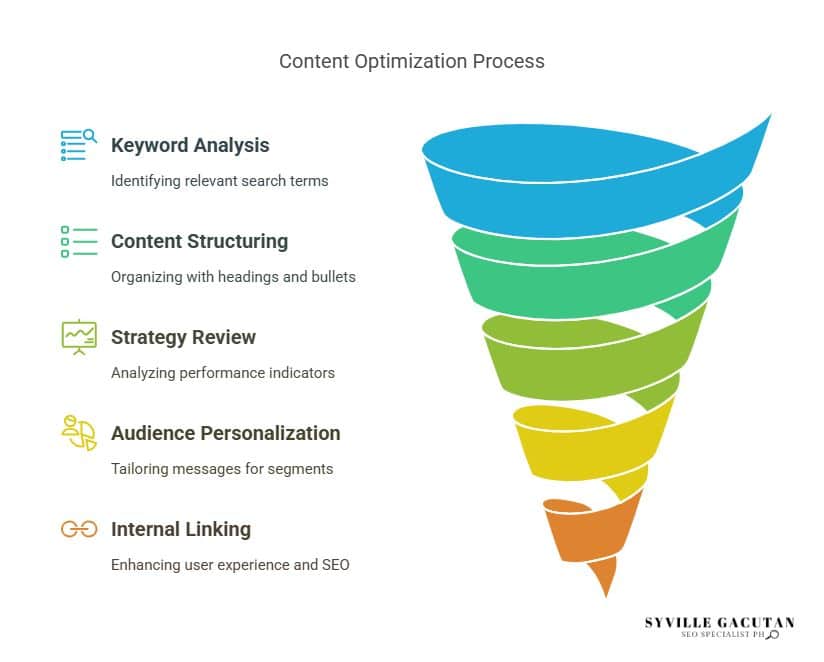
Top SEO Practices for Content Marketers: A Guide
Top SEO practices for content marketers include thorough keyword research to align content with user search queries and strategic alignment with user intent to fulfill their informational needs. Personalizing content via audience segmentation and crafting engaging headlines can significantly boost engagement. Marketers should also focus on content optimization to maximize ROI, using data-driven insights. Strategic content structuring and internal linking improve readability and user experience while establishing authority through content promotion and competitive benchmarking. Aligning content strategy with business goals ensures coherence and effectiveness. Exploring these best SEO practices for content marketers reveals more profound insights into optimizing content for success.
Key Takeaways
- To increase visibility and match content with audience search queries, do in-depth keyword analysis.
- Optimize content structure with clear headings and bullet points for better searchability and reader engagement.
- Continually review and improve content strategy in light of performance indicators such as conversion rates and organic traffic.
- Personalize content through audience segmentation and tailored messaging to increase engagement and retention.
- To improve user experience and efficiently spread page authority throughout the website, employ internal linking.

Establish Your Authority Through SEO-Driven Content

In today’s digital landscape, a brand’s authority is significantly bolstered through the strategic implementation of SEO-driven content. By meticulously conducting keyword research, businesses can pinpoint the precise phrases and terms their target audience frequently searches for. This foundational step not only guides content creation but ensures alignment with user intent, ultimately enhancing visibility on search engines.
Once content is crafted, content promotion becomes a pivotal phase. It involves strategically disseminating the material across various platforms to maximize reach and engagement. This process is not merely about distribution; it requires an understanding of audience analysis to tailor content that resonates with specific segments effectively. This ensures that the right message reaches the right people, thereby fostering a deeper connection with the target audience.
Furthermore, competitive benchmarking is essential for establishing authority. By analyzing the SEO strategies of leading competitors, brands can identify gaps and opportunities within their own content approach. They can differentiate their offerings thanks to this insight.and position themselves as thought leaders in their respective industries.
Lastly, measuring success through performance metrics is crucial in the SEO-driven content strategy. Metrics such as organic traffic, bounce rate, and conversion rates offer insightful data on the efficacy of content initiatives. By regularly evaluating these indicators, brands can refine their approach, ensuring continuous improvement and sustained authority in the digital sphere.
In essence, establishing authority through SEO-driven content requires a holistic approach, integrating keyword research, content promotion, audience analysis, competitive benchmarking, and performance metrics to create impactful and authoritative digital content.
Personalize Content to Engage Individual Audience Members

Although digital content is widely accessible, personalizing it to engage individual audience members remains a nuanced art that can significantly enhance user interaction and loyalty. The key to effective personalization lies in being aware of the various demands and preferences of your audience through audience segmentation. By categorizing your audience into distinct groups based on demographics, behaviors, or interests, you can craft customized messaging that speaks to each individual more profoundly.
In this process, it is essential to comprehend user intent. By analyzing the specific goals and motivations that bring users to your content, you can create dynamic content that adapts to their needs in real-time. This might involve using algorithms and data analytics to modify content elements such as product recommendations, articles, or visuals, ensuring they align with the user’s current interests or stage in the buyer’s journey.
This strategy is improved by behavioral targeting, which monitors interactions across several touchpoints. You can improve your tactics and provide more pertinent experiences by tracking how consumers interact with your material. For example, providing more in-depth material or relevant products to a user who regularly reads articles on a certain topic might boost engagement.
Including these components in your plan for content marketing not only makes your content more relevant to individual users but also fosters a sense of connection and value. As a result, personalized content can lead to higher retention rates, increased conversions, and a more loyal audience base.
Align Your Content Strategy With Business Goals for Success
Personalization in content marketing not only deepens audience engagement but also sets the stage for aligning your content strategy with overarching business goals. Establishing content alignment with corporate objectives is essential to making sure that each piece of material serves a definitive purpose within your broader strategic framework.
This means your content should not merely entertain or inform but should actively contribute to achieving specific business goals, such as increasing brand awareness, driving leads, or boosting sales.
Strategic planning is the cornerstone of effective content marketing. Begin by clearly defining your business objectives, and then outline how your content can support these aims.
For instance, if expanding market reach is a priority, your content strategy should focus on creating materials that resonate with new demographics or regions. This approach guarantees that the content you produce is not only relevant but directly tied to measurable outcomes, allowing for clear evaluation and adjustment where necessary.
Performance metrics play a pivotal role in this alignment process. By establishing concrete KPIs, you can assess the success of your content against your business objectives.
Metrics such as engagement rates, conversion rates, and customer retention can provide valuable insights into how well your content strategy aligns with your goals. Regularly reviewing these metrics enables you to refine your approach, ensuring ongoing alignment and effectiveness.
Optimize Content to Maximize ROI

Maximizing return on investment (ROI) in content marketing hinges on the strategic optimization of your content. A crucial starting point is content auditing, which involves systematically evaluating your existing content to identify strengths, weaknesses, and opportunities for improvement. By doing so, you can ensure that your content aligns well with current business objectives and effectively addresses the ever-evolving needs of your audience.
Keyword analysis plays a pivotal role in optimizing content for better ROI. This process entails identifying and integrating relevant keywords that resonate with user intent, ultimately enhancing search visibility and attracting qualified traffic. Understanding what users are searching for and why—user intent—enables you to tailor your content to meet their expectations, thereby increasing engagement and conversion rates.
Competitor benchmarking is another invaluable practice. By analyzing your competitors’ content strategies, you can glean insights into successful tactics and identify gaps in the market that your content can fill. This competitive insight not only informs strategic content adjustments but also empowers you to differentiate your offerings effectively.
Performance tracking is essential for continuous optimization efforts. By meticulously monitoring key performance indicators (KPIs) such as organic traffic, bounce rate, and conversion metrics, you can gauge the effectiveness of your content strategies and make informed decisions.
Regular performance tracking ensures that your optimization efforts are data-driven, allowing you to refine your approach and maximize ROI over time.
Crafting Search-Optimized Content That Engages Leads

Creating search-optimized content that effectively engages leads requires a strategic blend of creativity and analytical insight. The cornerstone of this strategy is thorough keyword research, which ensures that the content aligns with what potential leads are actively searching for.
Understanding user intent is crucial, as it guides the creation of content that not only attracts attention but also fulfills the informational needs of the audience. This understanding can transform simple keyword lists into powerful tools for crafting targeted, relevant content.
An engaging content structure is essential for maintaining a lead’s interest. Organizing content with clear headings, subheadings, and bullet points can enhance readability and keep readers engaged. Such a structure also assists search engines in better understanding the content, boosting its searchability.
Using engaging headlines is another vital element; they serve as the initial hook to capture the attention of potential leads. A well-crafted headline can significantly increase click-through rates and draw more traffic to the content.
Additionally, internal linking plays a pivotal role in crafting search-optimized content. It helps distribute page authority throughout a website and guides readers to additional relevant content, thereby increasing engagement and reducing bounce rates.
When strategically implemented, internal links can enhance the user experience by providing a seamless navigation journey.
Final Thoughts
Implementing top SEO practices for content marketing is essential for enhancing visibility and driving engagement. By conducting thorough keyword research and aligning content with user intent, marketers can create material that resonates with their audience’s needs. Personalizing content through audience segmentation and crafting compelling headlines significantly boosts user interaction. Additionally, optimizing content structures and leveraging internal linking improves readability and user experience while establishing authority through strategic promotion. Regularly reviewing performance metrics allows for ongoing refinement of the content strategy.
Want to take your content marketing strategy to the next level? Connect with Syville Gacutan, a skilled SEO Specialist in the Philippines, who can help you craft data-driven, search-optimized content that drives results. Reach out to Syville today and start maximizing your content’s impact.